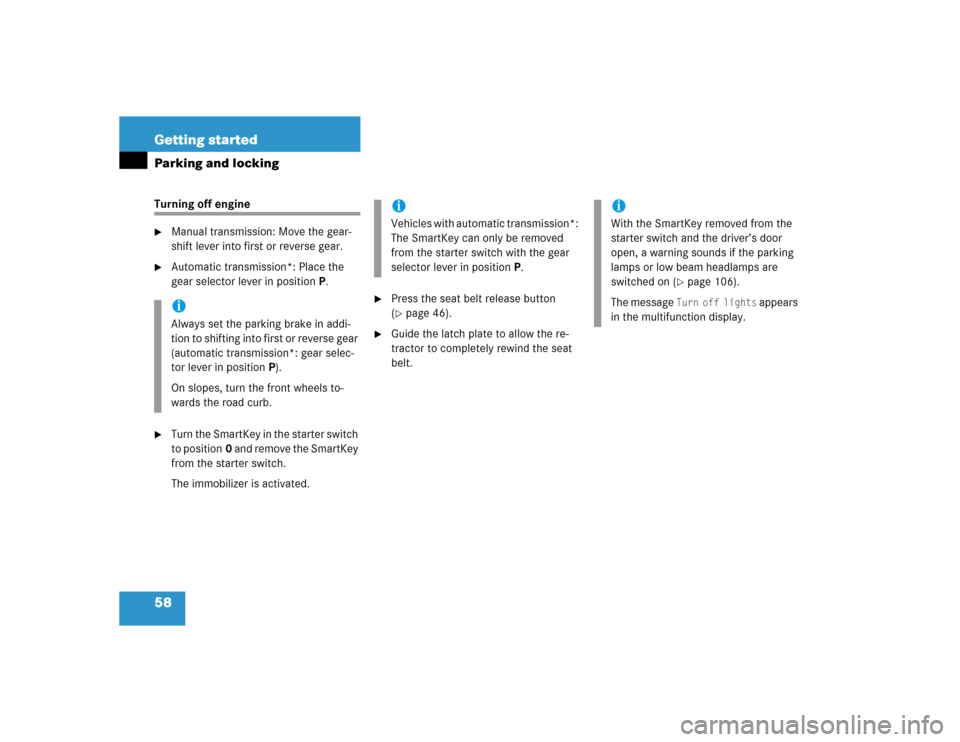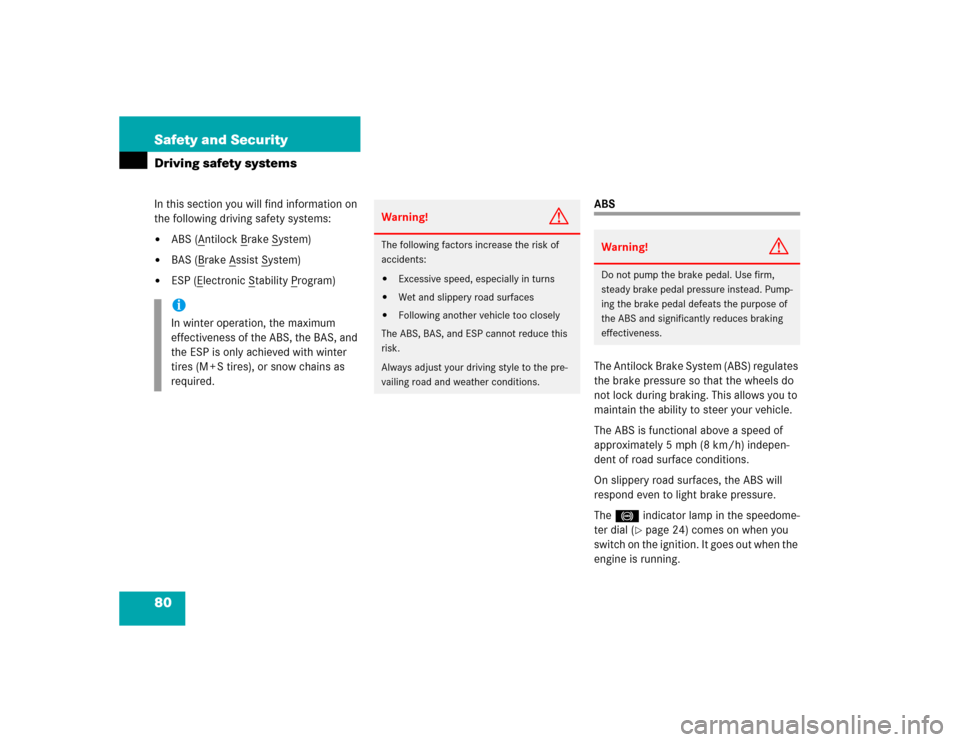Page 48 of 464
48 Getting startedDrivingManual transmissionGearshift pattern for manual transmissionFor more information, see “Manual trans-
mission” (
�page 150).Starting
�
Depress brake pedal.
�
Make sure the gearshift lever is in neu-
tral position (no gear selected).
�
Fully depress the clutch pedal.
Otherwise the engine cannot be start-
ed due to the integrated safety inter-
lock.
�
Do not depress accelerator.
�
Turn the SmartKey in the starter switch
to position3 (
�page 35) and hold until
the engine starts.
For information on turning off the engine,
see “Turning off engine” (
�page 58).Automatic transmission*
Gearshift pattern for automatic
transmissionPPark position with gear selector lever
lock
RReverse gear
NNeutral position
DDrive position
For more information, see “Automatic
transmission*” (
�page 152).
Page 49 of 464

49 Getting started
Driving
Starting�
Place the gear selector lever in
positionP.
�
Do not depress the accelerator.
�
Turn the SmartKey in the starter switch
to position3 (
�page 35) and release it
again immediately. The engine starts
automatically.
�
Depress the brake pedal.
The gear selector lever lock is released.
For information on turning off the engine,
see “Turning off engine” (
�page 58).Starting difficulties
If the engine does not start as described,
carry out the following steps:
�
Turn the SmartKey in the starter switch
to position0 and repeat the starting
procedure.
Remember that extended starting at-
tempts can drain the vehicle battery.
�
Get a jump start (
�page 399).
If the engine does not start after several
starting attempts, there could be a mal-
function in the engine electronics or in the
fuel supply system.
�
Notify an authorized Mercedes-Benz
Center.Parking brake
Warning!
G
When leaving the vehicle, always remove the
SmartKey from the starter switch, take it
with you, and lock the vehicle. Do not leave
children unattended in the vehicle, or with
access to an unlocked vehicle. Children
could release the parking brake, which
could result in an accident and/or serious
injury.
Page 50 of 464
50 Getting startedDriving1Parking brake lever
2Release button�
Pull up slightly on parking brake
lever1 and press release button2.
�
Push parking brake lever1 down to
its original position.
The brake warning lamp; (USA
only) or3 (Canada only) in the
speedometer dial goes out.Driving
Warning!
G
On slippery road surfaces, never downshift
in order to obtain braking action. This could
result in drive wheel slip and reduced vehi-
cle control. Your vehicle’s ABS will not pre-
vent this type of loss of control.
!If you hear a warning signal when driv-
ing off, you have forgotten to release
the parking brake.!Simultaneously depressing the acceler-
ator pedal and the brake pedal reduces
engine performance and causes pre-
mature brake and drivetrain wear.iOnce the vehicle is in motion, the auto-
matic central locking system engages
and the locking knobs drop down.
For more information, see “Opening
the doors from the inside” (
�page 94).
Page 51 of 464

51 Getting started
Driving
Manual transmission�
Depress the brake pedal.
�
Fully depress the clutch pedal.
�
Move gearshift lever to first gear to
drive forward, or to reverse gear to
drive rearward.
�
Simultaneously release the brake pedal
and slowly the clutch pedal.
�
Carefully depress the accelerator
pedal.Automatic transmission*
�
Depress the brake pedal.
The gear selector lever lock is released.
�
Move gear selector lever to positionD
to drive forward, or to positionR to
drive rearward.
�
Release the brake pedal.
�
Carefully depress the accelerator
pedal.!Wait for the gear selection process to
complete before setting the vehicle in
motion.iDuring the brief warm-up, transmission
upshifting is delayed. This allows the
catalytic converter to heat up more
quickly to operating temperature.
Warning!
G
Vehicles with automatic transmission: It is
dangerous to shift the gear selector lever
out of
PorN if the engine speed is higher
than idle speed. If your foot is not firmly on
the brake pedal, the vehicle could acceler-
ate quickly forward or in reverse. You could
lose control of the vehicle and hit someone
or something. Only shift into gear when the
engine is idling normally and when your right
foot is firmly on the brake pedal.
Page 56 of 464

56 Getting startedParking and lockingYou have now completed your first drive.
You have properly stopped and parked
your vehicle. End your drive as follows.
Parking brake
1Parking brake lever
2Release button�
Pull up parking brake lever1 firmly.
When the engine is running, the brake
warning lamp; (USA only) or3
(Canada only) in the speedometer dial
comes on.
Warning!
G
Vehicles with manual transmission:
Wait until the vehicle is stationary before re-
moving the SmartKey from the starter
switch. The vehicle cannot be steered when
the SmartKey is removed.Warning!
G
With the engine not running, there is no
power assistance for the brake and steering
system. In this case, it is important to keep
in mind that a considerably higher degree of
effort is necessary to brake and steer the ve-
hicle.
Warning!
G
Do not park this vehicle in areas where com-
bustible materials such as grass, hay or
leaves can come into contact with the hot
exhaust system, as these materials could be
ignited and cause a vehicle fire.
To reduce the risk of personal injury as a re-
sult of vehicle movement, before turning off
the engine and leaving the vehicle always:�
Keep right foot on brake pedal.
�
Pull up the parking brake lever firmly.
�
Move the gear selector lever* to
position
P (manual transmission: first or
reverse gear).
�
Slowly release brake pedal.
�
When parked on an incline, turn front
wheels towards the road curb.
�
Turn the SmartKey in the starter switch
to position
0 and remove the SmartKey
from the starter switch.
�
Take the SmartKey and lock vehicle
when leaving.
Page 57 of 464

57 Getting started
Parking and locking
Switching off headlamps�
Turn exterior lamp switch toM
(�page 52).
For more information, see “Lighting”
(
�page 106).
Warning!
G
Getting out of your vehicle with the gear se-
lector lever* not fully engaged in positionP
(manual transmission: first or reverse gear)
is dangerous. Also, when parked on an in-
cline, positionP (manual transmission: first
or reverse gear) alone may not prevent your
vehicle from moving, possibly hitting people
or objects.
Always set the parking brake in addition to
shifting to positionP (manual transmission:
first or reverse gear).
When parked on an incline, turn the front
wheels towards the road curb.
Warning!
G
When leaving the vehicle, always remove the
SmartKey from the starter switch, take it
with you, and lock the vehicle. Do not leave
children unattended in the vehicle, or with
access to an unlocked vehicle. Children
could release the parking brake and/or
move the gear selector lever* from
positionP (manual transmission: into
Neutral), either of which could result in an
accident and/or serious injury.
Page 58 of 464

58 Getting startedParking and lockingTurning off engine �
Manual transmission: Move the gear-
shift lever into first or reverse gear.
�
Automatic transmission*: Place the
gear selector lever in positionP.
�
Turn the SmartKey in the starter switch
to position0 and remove the SmartKey
from the starter switch.
The immobilizer is activated.
�
Press the seat belt release button
(�page 46).
�
Guide the latch plate to allow the re-
tractor to completely rewind the seat
belt.
iAlways set the parking brake in addi-
tion to shifting into first or reverse gear
(automatic transmission*: gear selec-
tor lever in positionP).
On slopes, turn the front wheels to-
wards the road curb.
iVehicles with automatic transmission*:
The SmartKey can only be removed
from the starter switch with the gear
selector lever in positionP.
iWith the SmartKey removed from the
starter switch and the driver’s door
open, a warning sounds if the parking
lamps or low beam headlamps are
switched on (
�page 106).
The message Turn off lights
appears
in the multifunction display.
Page 80 of 464

80 Safety and SecurityDriving safety systemsIn this section you will find information on
the following driving safety systems:�
ABS (A
ntilock B
rake S
ystem)
�
BAS (B
rake A
ssist S
ystem)
�
ESP (E
lectronic S
tability P
rogram)
ABS
The Antilock Brake System (ABS) regulates
the brake pressure so that the wheels do
not lock during braking. This allows you to
maintain the ability to steer your vehicle.
The ABS is functional above a speed of
approximately 5 mph (8 km/h) indepen-
dent of road surface conditions.
On slippery road surfaces, the ABS will
respond even to light brake pressure.
The -indicator lamp in the speedome-
ter dial (
�page 24) comes on when you
switch on the ignition. It goes out when the
engine is running.
iIn winter operation, the maximum
effectiveness of the ABS, the BAS, and
the ESP is only achieved with winter
tires (M + S tires), or snow chains as
required.
Warning!
G
The following factors increase the risk of
accidents:�
Excessive speed, especially in turns
�
Wet and slippery road surfaces
�
Following another vehicle too closely
The ABS, BAS, and ESP cannot reduce this
risk.
Always adjust your driving style to the pre-
vailing road and weather conditions.
Warning!
G
Do not pump the brake pedal. Use firm,
steady brake pedal pressure instead. Pump-
ing the brake pedal defeats the purpose of
the ABS and significantly reduces braking
effectiveness.